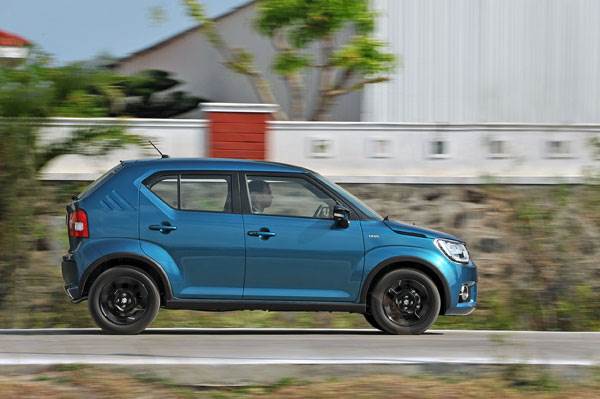2017 Maruti Ignis review, test drive
The radical Ignis breaks Maruti convention to chase young and funky car buyers.
Published on Jan 19, 2017 03:00:00 PM
1,01,562 Views
Follow us on



What’s it like to drive?
Unconventionally, we were given an opportunity to begin our drive at night and that’s probably because Maruti wanted to show off a new feature – sparkly new LED projector headlamps. The S-cross and Baleno both make do with bi-xenon projectors. So, we head out at night to sample the four powertrain options on offer. The Ignis comes with the 1.2-litre petrol and the 1.3-litre diesel units from the Baleno, with a choice of a 5-speed manual or a 5-speed automated manual gearbox, making it the only car at this price point to offer an automatic with both petrol and diesel engines.
We took the petrol manual out first and, wow, what a great start to a drive. The unit is peppy and eager and the gearshifts are nice and quick with a positive feel to them. The clutch, however, is not very progressive and getting smooth starts needed a bit of concentrated pedal work. Power is available right from low revs and past 2,500rpm, the unit has a nice stronger surge. Rev the engine hard and it gets loud, but it’s a nice and sporty tone and the eager-footed will see themselves doing this quite often. Sadly, the only fly in the ointment is the steering. It's too light with no real connected feel and, typical of many Marutis, it doesn't centre after a turn.
| Maruti Suzuki Ignis Price, Mileage, Specifications, Features and Variants | |
|---|---|
| Brand | Maruti Suzuki |
| Model Name | Ignis |
| Maruti Suzuki Ignis Price | ₹ 6.49 - 9.14 lakh |
| Maruti Suzuki Ignis Range/Mileage | Petrol : 20.89kpl |
| Maruti Suzuki Ignis Specifications | Hatchback | 5 doors | 5 seats View All Specs |
| Maruti Suzuki Ignis Features | LED headlight | 7-inch Touchscreen display | 2 airbags View All Features |
| Maruti Suzuki Ignis Variants | 1.2 K12 Sigma | 1.2 K12 Delta | 1.2 K12 Delta AMT View All Variants |
The ride is another highlight of the Ignis. It moves like a car that's a lot heavier with a nice sure-footedness and does not get tossed around a lot on bumps and potholes. We switch to the diesel and it does feel a bit stiffer, but this is only in comparison. On the whole, all the Ignis models offer a well- composed ride. The diesel manual has a slightly heavier clutch but also a heavier steering – a welcome addition as it brings in a bit of feel. The engine is nice and drivable and does not suffer from very noticeable turbo lag. Power comes in above 2,000rpm until about 4,000rpm, after which the delivery begins to taper. The sound levels, however, do increase and this engine isn’t as refined as a few others at this price point.

Switch to a diesel AMT and the drivability sees a dip. The shift speeds aren’t a problem during light throttle inputs when you are pottering around town in slow-moving traffic. It’s when you want to get a quick move on, like in start-stop traffic or overtaking on highways that the pause between shifts becomes apparent. You will have to work around this using the manual selector, and what’s nice is that in manual mode the car lets you rev until the redline. Things improve on the petrol AMT with the shifts becoming less perceptible. However, in comparison to the diesel AMT, the manual 'box is the far more enjoyable drive experience. Unless, our crazy city traffic kills it for you, in which case you’ll have to settle for the AMT and reach for that tip lever from time to time.
Copyright (c) Autocar India. All rights reserved.




Comments
Member Login
Personal Details
No comments yet. Be the first to comment.